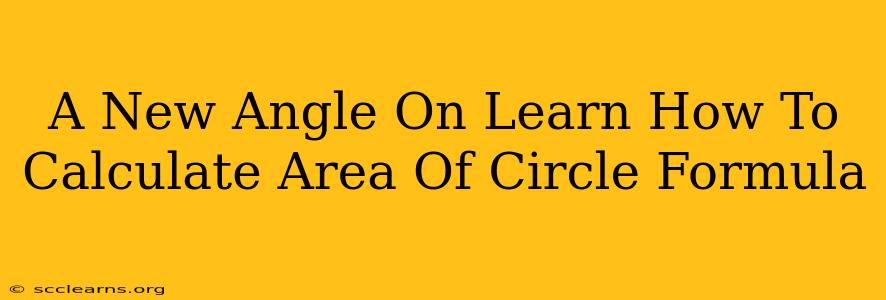Calculating the area of a circle might seem like a straightforward task, but understanding the why behind the formula is crucial for truly grasping the concept. This isn't just about plugging numbers into a formula; it's about understanding the relationship between a circle's radius and its area. Let's explore this fundamental concept from a fresh perspective.
Understanding the Circle Area Formula: πr²
The formula for calculating the area of a circle is A = πr², where:
- A represents the area of the circle.
- π (pi) is a mathematical constant, approximately equal to 3.14159. It represents the ratio of a circle's circumference to its diameter.
- r represents the radius of the circle (the distance from the center to any point on the circle).
This seemingly simple formula encapsulates a profound geometric relationship. Let's break it down:
Visualizing the Formula: Beyond Simple Substitution
Imagine dividing a circle into a large number of thin, triangular slices. The more slices you create, the more accurately these slices approximate triangles. Each of these triangles has a base along the circle's circumference and a height approximately equal to the circle's radius.
The area of a single triangle is given by: (1/2) * base * height.
If we sum the areas of all these tiny triangles, we get an approximation of the circle's area. As the number of triangles approaches infinity, this approximation becomes exact. Notice something interesting: the sum of the bases of all the triangles approximates the circumference of the circle (2πr), and the height of each triangle is the radius (r).
Therefore, the total area can be approximated as:
(1/2) * (2πr) * r = πr²
This visual approach helps solidify the connection between the formula and the geometric properties of the circle, moving beyond rote memorization.
Practical Applications: Where Do We Use This?
Understanding how to calculate the area of a circle isn't just an academic exercise; it has numerous real-world applications:
- Engineering: Calculating the area of circular components in machinery, pipelines, or construction projects.
- Architecture: Designing circular features, determining the area of a circular room or space.
- Agriculture: Calculating the area of irrigated land using circular sprinkler systems.
- Real Estate: Determining the size of circular plots of land.
- Everyday Life: Calculating the area of a pizza, a circular garden bed, or any other circular object.
Beyond the Basics: Exploring Related Concepts
Mastering the area of a circle formula opens doors to understanding more complex geometric concepts:
- Volume of Cylinders and Cones: The area of a circle is crucial in calculating the volume of three-dimensional shapes like cylinders and cones.
- Circular Sectors and Segments: This knowledge forms the foundation for understanding the area of parts of a circle.
- Trigonometry and Calculus: The concept expands to more complex mathematical fields like trigonometry and calculus.
Conclusion: Embrace the "Why"
Ultimately, learning to calculate the area of a circle effectively involves more than just memorizing a formula. By understanding the why behind the equation, you'll build a stronger foundation in mathematics and develop a more intuitive grasp of geometry. This new perspective allows you to approach problem-solving with confidence and apply your knowledge to various real-world scenarios. So, ditch rote learning and embrace a deeper understanding of this fundamental geometric concept!

